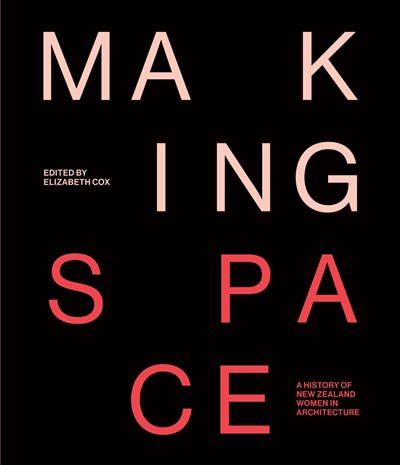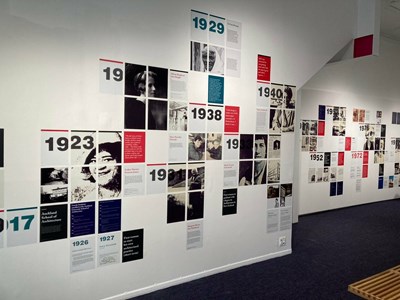Every day in Aotearoa New Zealand, initiatives and individuals contribute to architecture becoming a more equitable and inclusive profession. The cumulative effect is profound, and the milestones cause for celebration.
Some of those recent industry way finders include Julie Stout’s 2021 Gold Medal award – New Zealand Institute of Architects Te Kāhui Whaihanga’s highest honour – and, more recently, the publication of Making Space, A History of New Zealand Women in Architecture, by Elizabeth Cox.
As soon as the groundbreaking book was off the press late last year, it not only made visible the hundreds of women who have contributed to our built environment, it also made redundant ‘Invisible Histories’, the elective course at the University of Auckland Waipapa Taumata Rau taught by Lynda Simmons, architect and co-founder of Architecture+Women NZ.
Invisible Histories drew from Architecture+Women NZ’s archives, which acknowledge many women architects and designers, and that Simmons made available to Cox as a contribution to her extensive research. The majority of those women now feature in Making Space and are among more than 300 women that Cox has documented.
Simmons notes that until 2010, only 14 New Zealand women had been documented in architecture books. Compulsory history courses of New Zealand architecture taught at our universities have until now included between 2% and 22% of women in its material. With Making Space available to all students, this wealth of information can be included in the compulsory curriculum. “I no longer need to teach Invisible Histories, and happily so,” says Simmons.
In 1975, the United Nations established International Women’s Day, recognised annually on March 8, to honour women’s achievements in creating fair and equitable societies, and to focus attention on gender rights and equity. At that time in Aotearoa there were less than a handful of female students at the University of Auckland’s architecture school. (Incidentally, with no bathroom facilities provided for them, they had to use the staff facilities.) Despite the cultural climate of the time, women were already breaking ground. In 1967, the Institute awarded its first medal to a woman – Lillian Chrystall – for the Yock House in Remuera, Auckland Tāmaki Makaurau. Chrystall’s remarkable influence on the architecture community endured until her passing last year.
A little more than 30 years after the launch of International Women’s Day, gender parity across all architecture schools in Aotearoa was achieved, and by 2018, female students were tipping the scales in numbers. These figures reveal the remarkable advancements women have made in the industry and are reflected in the Institute’s current membership and fellowship – 50 of the Institute’s 178 fellows and distinguished fellows are women, and of its 1233 architects, 610 are female.
While the micro builds momentum towards recognisable change and the macro speaks to milestones, occasionally disruption to entrenched and prohibitive workplace practices comes from unlikely corners. With the biggest obstacle to women advancing their careers in architecture being the lack of workplace flexibility, the Covid-19 pandemic forced the issue.
“Just look at the agility of the profession during lockdowns,” says Simmons, “and the ongoing benefits to so many workers and workplaces who experienced flexible working for the first time. The biggest barrier to women working in architecture is actually a non-gendered issue, and it is sidelined because it has until recently been treated as an issue belonging to women. Flexibility, including respect for part-time careers, benefits all genders.”
With the wisdom of experience, the collective call from women in architecture is that inclusivity not only benefits the entire industry, but helps form a more complete picture of how it can successfully shape our rapidly involving environment. In recognising International Women’s Day, the Institute discussed the evolving cultural climate and this year’s theme – ‘DigitALL: Innovation and technology for gender equality’ – with members and industry professionals.
“As in society generally, the discussion continues about workplace flexibility and diversity inclusion as we recognise the benefits of the breadth of perspectives,” says Christina van Bohemen, director of Sills van Bohemen and Institute Past President.
“We should be working together as a collective to ensure everyone, no matter their gender, abilities, race, or beliefs, is provided with the support and resources they require to succeed,” says Renée Williamson, a Nelson-based architect with Arthouse Architects, and past board director of Emerge, the Institute graduates’ and emerging designers’ group. “I often see women leave to start a family, and never return to the profession,” she says.
Recent registration figures reflect the gender-skewed loss of female architects from the industry. At 30%, they are up from 18% in 2008, but fall short of the 50% that decades of graduates would imply. Technology, as it proved during Covid-19 lockdowns, has the potential to promote meaningful changes to workplace equity and inclusion, says Melanie Tristram, associate principal and digital delivery lead at Jasmax.
“Technology has made it possible for people to work remotely, helping to reduce barriers and increase opportunities for those returning to the workforce, and allowing a better work-life balance for those who work remotely,” says Tristram. “Using technology to analyse data within the workplace to understand the diversity of employees can inform strategies for creating a more equitable environment, one that values the contributions and potential of people from all walks of life,” she says.
“In creating a world as diverse and inspiring as the people in it, architecture needs to represent everyone,” says Te Kāhui Whaihanga chief executive Teena Hale Pennington, who encourages all members to sign the Diversity Agenda Accord, which promotes equity within the architecture and engineering sectors, and to support diversity and inclusion this International Women’s Day.













